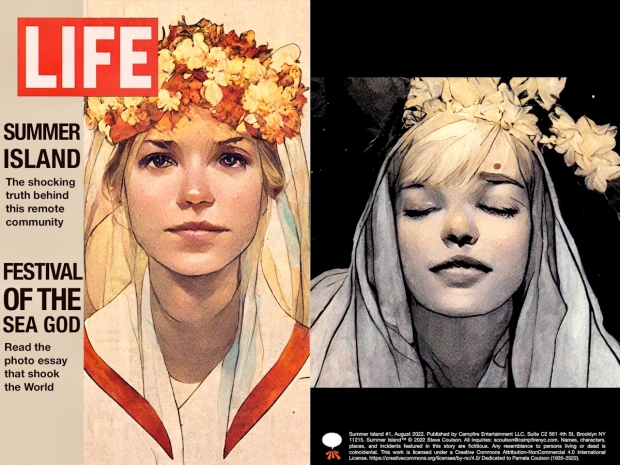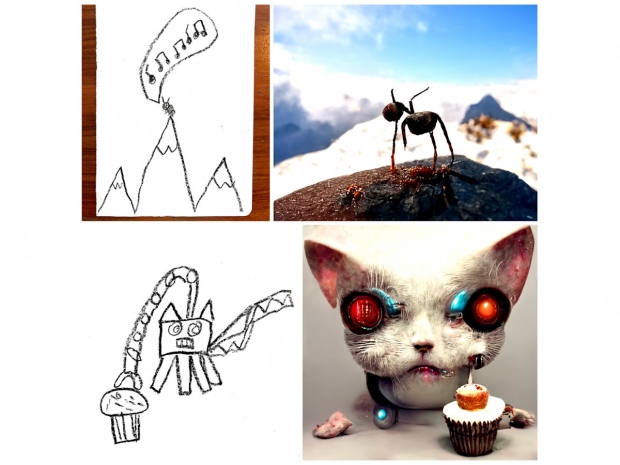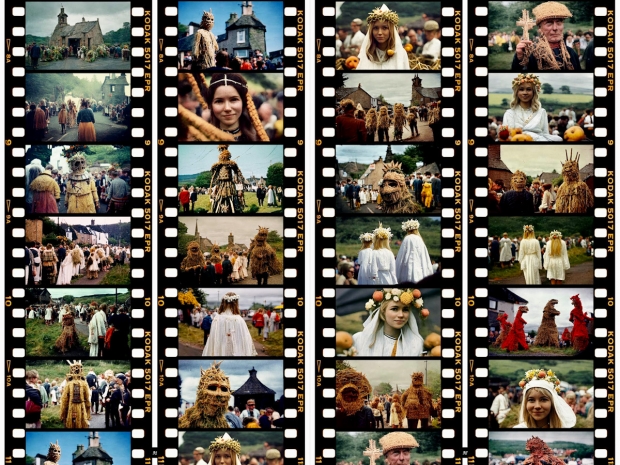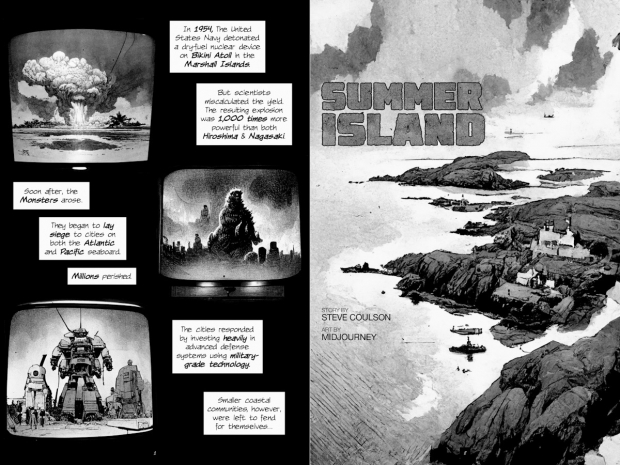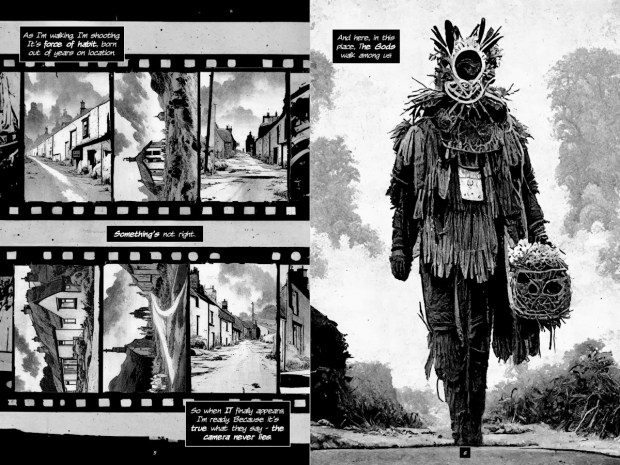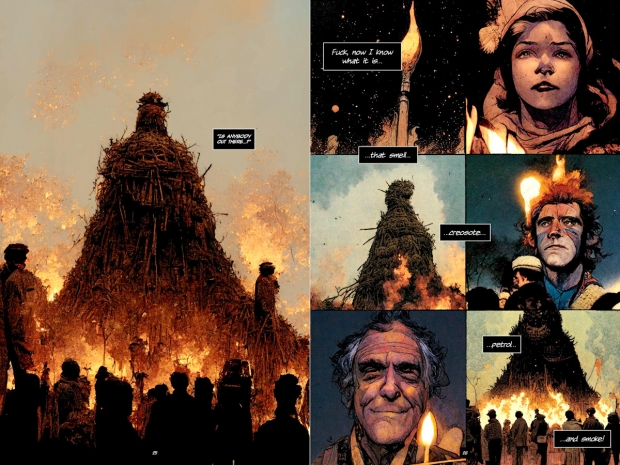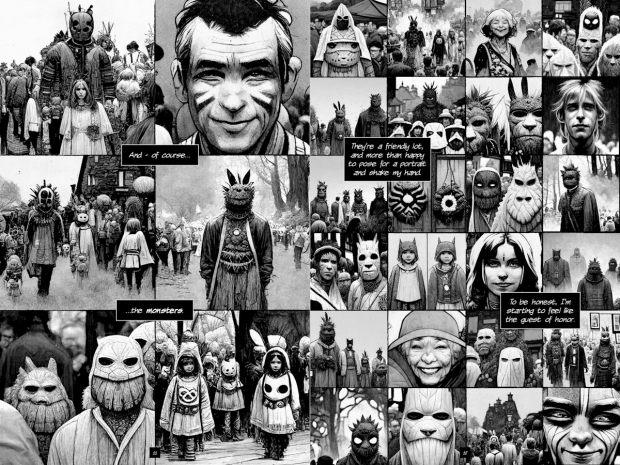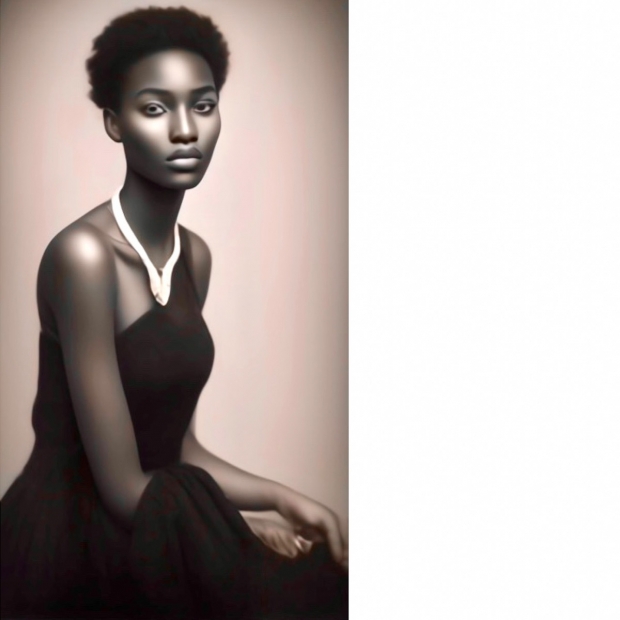Transmedia creator and ‘SUMMER ISLAND’ author Steve Coulson discusses AI-generated content and the disruptive future of entertainment.
AI-generated imagery has been around since the 1960s, but the recent releases of DALL·E, Midjourney, and other natural language-based AI image generators have unleashed a fresh round of handwringing about “The Death of Art” and the displacement of human artists.
We now live in a world where everyone has been granted a “Green Lantern ring” capable of manifesting any thought (or prompt) in vivid imagery that is either beyond your ability to create or beyond your ability to create in the 60 seconds or less that the AI needs to generate new data based on learning patterns.
On the one hand, it’s all good fun, such as my pal Anders Beer’s prompt: “Will Ferrell in a wrestling match with Paris Hilton”…
Or the dueling banjos-style showdown between my young daughter and an AI on the prompts: “an ant singing on a mountaintop” and “a cat with a robot arm holding a cupcake”…
An IP washing machine
On the other hand, it’s a sea change with disruptive commercial and ethical ramifications.
Artists from Rembrandt van Rijn to Jeff Koons have employed assistants in the course of producing their work, so on the face of things, an AI assistant is merely a 21st century twist on that tradition. Marvel Studios concept artist Karla Ortiz observes:
“I could see myself utilizing AI-generated imagery for initial visual references and inspiration. What if I wish to paint an object in a particular light scheme or require a specific texture in a specific shape? AI would be an invaluable tool to assist me in my artwork. For some artists, AI would be an absolute game-changer, allowing them to have nearly immediate references to further inspire and potentially inform.”
For many creatives, myself included, the prospect of leveraging AI is too compelling to ignore. Incorporating digital and now generative tools into our workflows is a natural progression. The fact that anyone can submit a phrase to an AI image generator and produce a result is no more disturbing than the fact that anyone can walk into an art supply store and produce a result.
But for others, the prospect of machine learning technology being applied by producers to circumvent the costs of dealing with human artists is no longer the stuff of dystopian futurism. The displacement threat is here, now.
Those content producers who may be inclined to brush aside such concerns as Luddite foot-dragging would do well to consider the ethical and legal dilemma posed by AI “data scraping.” While AI image generation is fun for casual users, and promising for tech-forward creators, digital artist Jon Juarez (Square Enix, Microsoft) notes that AI platforms function as “washing machines of intellectual property.” Technology is progressing faster than the law can keep up, and there is no definitive copyright stance on machines producing images synthesized from human art.
“SUMMER ISLAND”
Amid this scrum, I came across “SUMMER ISLAND:” a fascinating 40-page folk-horror comic written by Steve Coulson, with artwork generated by Midjourney AI. I’ve seen a few of these attempts at AI-aided storytelling and felt that Coulson did an outstanding job using AI image generation in a smart way for his short-form horror story. I also appreciated how he summarized his motivation and process in the end notes of the comic, so I contacted Steve for the interview below.
As a storyteller with a history of experimenting with the possibilities of new technologies, Coulson’s insightful observations range from the practical to the philosophical: addressing the promise and the problems, the inevitability and the ethics of the AI-aided creative process. Given the exponential pace of AI technology, it’s worth noting that this interview was recorded on August 22nd, 2022 — a lifetime ago where AI image generation is concerned.
KEVIN: Steve, thank you for joining us. It’s fascinating to see what you’re doing with AI image generation. Why don’t you tell us a bit about your background prior to creating your AI-mediated folk horror comic, “SUMMER ISLAND?”
STEVE: Sure, and thanks for having me. My name is Steve Coulson, and I’m the Co-owner and Creative Director of a company called Campfire, based in New York City. We’ve been around for about 13 years and specialize in creating immersive fan experiences for entertainment, properties, and brands. For example, a TV company will come to us and say, “We have a new show launching. We think there will be a large fan base and need to get them excited. Let's create an event — an instance of something to immerse them in the story world alongside the show.” So we help launch those immersive experiences and fantasy worlds. We’ve done work for Watchmen, Game of Thrones, Westworld, and Ted Lasso. If you check out our website at www.campfirenyc.com, you’ll see the kind of work that we do: storytelling that bridges the physical and digital worlds.
KEVIN: Very cool.
Simulating authenticity
STEVE: A good example of the type of project that comes under our purview is Amazon Studios’ 2015 adaptation of Philip K. Dick’s “The Man in the High Castle:” a very dark alternate history in which the Nazis won World War II and America is under the thumb of the Axis powers. We created a radio station called “Resistance Radio” that broadcasts messages of hope from the neutral zone between the German-controlled and Japanese-controlled territories. So you could tune in to this radio station and listen to the DJs talking about their experiences and playing music in an oppressive world where rock & roll never developed. We partnered with Danger Mouse and did a very cool album of covers of traditional songs.
KEVIN: [Laughs] Wow!
STEVE: So that’s the kind of work we do. And I think it links directly into a project like “SUMMER ISLAND” because to create an immersive experience, it's really important to simulate authenticity. If I send you a box from the world of Game of Thrones, you want it to seem like it's come from a medieval world: the look and feel of it, the smell of it. I’ve always told my art directors to think like forgers. [laughs] Because if we do our job properly, we'll forge something so well that you can't tell the difference between the fake object and the real object — and that's how you establish and maintain immersion. So “SUMMER ISLAND” is an outgrowth of that exploration of simulated realities.
KEVIN: Did your current creative experimentation with AI come out of your day job, or was this something percolating on the sidelines? How did you get into it?
STEVE: My team and I are all dabblers. We like to be ahead of the curve and experiment with different technologies: virtual worlds, NFTs, etc… and see if there’s creative opportunity for us. I’ve been using Midjourney for a couple of months on a variety of projects — photo essays and so forth — just trying to push the limits of the technology and see what can be done.
KEVIN: I think you made really smart use of AI image generation technology on “SUMMER ISLAND,” which is a great graphic novel, by the way…
STEVE: Thank you.
KEVIN: …and I read in the end notes that it indeed began as a faux photo essay exploration that evolved into the story of a photo journalist visiting this mysterious island and getting in way over his head, literally and figuratively.
STEVE: Yes. I’m much more interested in sequential storytelling than in creating static pieces of art. So I started creating a photo essay that was inspired by “The Wicker Man” — with that particular early 70’s folk horror look and feel to it. I was really interested in exploring that aesthetic. Could I create a photo essay in Midjourney that felt like it was shot on location with a particular stock of Kodak film, with certain camera lensing in a specific aspect ratio? It’s that idea of thinking like a forger again. So I had a lot of fun with that photo essay, and when I finished I thought to myself: “I wonder if I could reroll the project and tell the exact same story in a completely different visual style as a test for what the system can do?”
KEVIN: Mmm.
STEVE: And I’m a life-long comics fan. You can see I have comics pages here on the walls behind me, and I have over 60 boxes of comics in my collection. So I wondered if I could tell this as a comics story. I’ve seen people on Midjourney — there are quite a few creators or “prompters” there — pulling together comic books. Most feel like European comics and take advantage of Midjourney’s sci-fi leanings…
KEVIN: [Laughs] You get a lot of establishing shots, moody close-ups and so forth…
STEVE: [Laughs] Yes, and that’s great. But I wanted to move beyond that and see if I could make a comic book that looks like a comic book — not like an AI trying to make a comic book. Can it feel hand-illustrated? Can it feel authentic? There are things about “SUMMER ISLAND” which I feel are very important. The aspect ratios of the images are the same as in American comics. It has all of the elements that we traditionally associate with comics. So when you read it, it feels real… but then there’s that moment of dissonance where you realize: “Wait a minute… no human hand drew this.”
KEVIN: You know, as a life-long comics fan myself, I was very impressed with what you achieved compared to the other attempts I've seen being made at this. If I didn’t already know that “SUMMER ISLAND” was an AI-mediated comic, that’s not the first thought that would have come to mind while reading it. The type of story you told, the way you told it, the way you applied the technology… demonstrates a high level of creative thought and design thinking, as reflected by your observations here. And I mention that because I’ve seen questions in some of the discussion threads where people have literally asked if you just give the AI your text and it magically spits out a full-blown comic for you [laughs].
STEVE: [Laughs] Uh, yeah… no.
KEVIN: It reminds me of the remarks that CG artists and animators such as myself got, and still sometimes get, where people think that the machine does most or all of the work for you. I think anyone who’s reading your comments in this interview can hopefully recognize the amount of insight, analysis, conceptualization, and design that’s required to apply AI image generation in a way that’s productive and supportive of your storytelling goals.
STEVE: Yes. I mean, look… I’m not tooting my own horn here, but I think if you’re going to spend some time on a project, it might as well be worthwhile. There are a lot of people who go on Midjourney and say, “Give me a gnome in a car” [laughs]. And they’re thrilled with the result and it’s fantastic, because it’s like magic. Arthur C. Clarke said that any sufficiently-advanced technology will seem like magic, and Midjourney absolutely feels like magic. In “SUMMER ISLAND”, I told the story of a community embracing a monster, and that was specifically chosen as an allegory for where Midjourney is today.
Embracing the monster
KEVIN: So what was it like working with this monster?
STEVE: [Laughs] You mean the process of making the comic itself? Well, I knew the story of “SUMMER ISLAND” because I had worked it through with the fake photo essay. I knew the tone, the pacing, and so on. I knew that I wanted to create a narrative within the comic — as any great comic has — that establishes beats with splash panels. Every three or four pages, I wanted a huge splash page.
KEVIN: Yes.
STEVE: Now at the time that I made “SUMMER ISLAND,” Midjourney had — and I said “had” because there’s been an update just in the last couple of days that addresses it — a problem with consistency. Midjourney is such a simple interface. You tell it what you want and it returns its best effort as to what that could look like. But there was no connection between images, no consistency. However, that continuity issue has just been addressed [laughs]
KEVIN: But at the time that you created “SUMMER ISLAND,” you were struggling to tell a sequential story with an AI image generator that wasn’t designed to support the graphic throughline necessary.
STEVE: Right. In Midjourney at that time, you could tell it what your character looks like, but would get different results from image to image. This was very difficult to get around. It’s one of the reasons why I designed a story with an unseen protagonist, so I didn’t have to worry about that.
KEVIN: Smart.
STEVE: And photojournalists are always unseen components of the story anyway, so this was an easy way to get around the limitations of the system.
KEVIN: What was the AI prompting process like in terms of tweaking your requests to get results you were happy with? You mention in the “SUMMER ISLAND” end notes that you need to ask the AI nicely. I can imagine you went through some pain in figuring that out [laughs]
STEVE: [Laughs] A bit. A comic book is a system, so I knew the page layouts I wanted and the aspect ratios of the images that I wanted. So that was always part of the prompt. Another key part of the prompt was the style, and that’s probably the most controversial part. A traditional comic has the consistency of the human artist’s hand. So how do you achieve that in Midjourney? The way to do it right now — controversially — is to ask Midjourney to mimic the style of a particular artist, or to blend the styles of two or more artists.
KEVIN: Right.
Thorny ethics
STEVE: And Midjourney will blindly, obediently obey your request like the world’s greatest art forger. So if I want a painting in the style of Caravaggio, it’ll go: “Here’s four. Which one do you like?” [laughs].
KEVIN: So you end up ripping off someone else’s style in an effort to direct the AI image generator towards consistency.
STEVE: Yes — and that’s a huge ethical question. If I instruct the AI to return images in the style of Neal Adams, what does that mean for Neal Adams? Does Neal Adams agree with that? I mean, I’m sure his work has already been scraped by Midjourney. That’s the only way it would learn. Now Neal Adams has passed away of course, so let’s consider a living comic book artist. In what ways does referencing a living artist in Midjourney infringe upon that artist’s rights and livelihood?
KEVIN: And then there’s the issue of life rights as well. I saw an AI comic done with Midjourney where the protagonist was clearly Zendaya [laughs].
STEVE: Mm-hmm.
KEVIN: And I thought, “Wow. You could find yourself in a lawsuit situation really fast by using the likeness of someone without their permission.” It gets pretty thorny when you dig into the ethical weeds.
STEVE: That is thorny. I saw that comic, and I don’t believe it’s because the prompter specifically wanted the character to look like Zendaya. If I tell the AI to make my main character look like Zendaya, which clearly it can do, then I'll get consistency from panel to panel. So I think it was a workaround to that end. But you're right — it’s thorny. It’s especially thorny because for my approach, I tried a whole bunch of references. I’d already done a project where I tried to recreate comic book covers ith all the famous comic artists of the past, and realized that I could say, “I want a comic book that looks kind of like Neal Adams, kind of like Nick Cardy and kind of like Curt Swan… you can give the prompt a whole list of names, and Midjourney will take all those styles and combines them for you.”
KEVIN: The AI synthesizes the styles into a hybrid.
STEVE: Yes — and I don't know about the ethics of that because there has been no comic book cover which those three artists drew together, certainly not as a hybrid of their respective styles. But I started experimenting with this… taking my broader style that was kind of photorealistic and doing tests listing different artists that I knew had a photorealistic style. I went through lots of these tests — listing the artists in different orders to see what I’d get — and eventually got it down to something that was very consistent and was the look I was going for.
KEVIN: Hmm.
STEVE: Now this is not a for-profit project: it’s an experiment that I’m giving away online. But it is concerning. How would the artists referenced by my prompts feel about me incorporating their styles without their permission — using an AI that has scraped their images without their awareness or consent? And what are the copyright ramifications? Comic books in America are notoriously work-for-hire, which means that Midjourney is scraping a lot of art that the artists themselves don’t even own anymore.
KEVIN: Right. The images are owned by Marvel or DC.
STEVE: Yeah. So what are the ramifications of that? It’s a difficult issue.
KEVIN: With respect to art history, it reminds me of the competitive relationship between Pablo Picasso and Georges Braque, and how many people considered Picasso as having “stolen” Cubist concepts from Braque: visiting Braque’s studio to see what he was doing and then creating work along the same lines but with far more artistic facility than Braque was capable of — essentially making Cubism his own.
STEVE: Right.
KEVIN: And I recall how in art school, my classmates and I were all preoccupied with not looking too much like this artist or that artist — even as we were heavily impressed and influenced by certain artists in the course of our studies. What most of us realized is that if you’re diligent and conscientious, you’ll eventually synthesize those influences with your personal preferences and life experiences to form an artistic persona which is ultimately true to yourself.
STEVE: Yes.
Surfing the tsunami
KEVIN: So it seems to me that if you’re using AI to conscientiously synthesize influences at an elemental level — in other words, if you’re not simply saying “in the style of Frank Miller” — you can arrive at results that are unique. You aren’t riding the coattails of another artist, and you aren’t infringing upon anyone or depriving anyone of anything.
STEVE: I think… look, you can be King Canute, right? You can sit there and try to tell the waves not to crash over you. But Pandora’s Box has been opened now, and I fully empathize with all the artists who are worried about this. I posted “SUMMER ISLAND” in two places: a Midjourney group on Facebook, which is where you saw it…
KEVIN: Yes.
STEVE: … and openly on Twitter.
KEVIN: [Laughs] Let me guess…
STEVE: I received a lot of positive comments and questions from people in the Facebook Midjourney group who are also exploring the technology. They saw “SUMMER ISLAND” as a step forward. And on Twitter, I got…
KEVIN: Hammered [laughs].
STEVE: …hammered. Mainly by artists, declaring: “This is unethical! You should have hired an artist to do this!” On a non-profit project, no less. [Laughs] Anyway, most of it is born out of fear from artists thinking that Midjourney is coming to take their jobs away.
KEVIN: Yes. And I've seen this divided reaction not only among different people on various forums, but within individuals. I've read comments from artists and designers who have said, “Oh my God… this is amazing and terrifying!” They have conflicting emotional reactions to the promise and the peril of the technology — the balance of which depends upon the creativity, intellect and ethics of the person using it in a way that is creative, not exploitative. But it’s like seeing a tsunami coming, right? You can either be hit by it, or you can try to surf it. Either way, it’s coming.
STEVE: It’s here. Now, don’t shoot the messenger… but if you are an illustrator or a concept artist, does AI image generation mean that you’re out of a job? I feel that I should say “no”, but the honest answer is probably “yes” — at least in the form that you currently know it. I hate to say it, but I think of all those practical model makers in Hollywood who were upended when CGI came along. This is an even bigger sea change that will have a profound effect on the democratization of visual imagery.
KEVIN: Yes. I have to say that as a creator myself — having worked for Disney in contexts ranging from CG supervisor to creative vice president, and now developing content as an independent producer — I’m really excited by this. And not because I’m thinking, “Oh, boy! Now I don’t have to pay anyone anymore!” But because I see how it can really supercharge those initial bootstrap efforts as an independent creator: where you’re struggling to get traction on a project and hook the interest of investors and distributors who can boost you into full production. So often, you’re doing what you can with your own two hands while grabbing public domain reference from the internet to show what you’re going for visually. And now you have the tools at your disposal to quickly synthesize something of high quality that has never been seen before — if you play your prompts right. AI has been plussing production for some time now, and it’s finally making its way into development. I believe that’s ultimately beneficial, but a lot of folks will be flipped by it. I started learning CGI in the early 90’s after getting tired of being a starving artist stereotype, and my entry into the film industry was boosted by Jurassic Park euphoria. I was on the right side of the digital revolution, but I know a lot of people who got creamed by it. Traditional model makers and animators, folks experienced with the old optical systems, were suddenly turned on their heads. Some adapted, while others didn’t. And I think we’re in for that here as well.
STEVE: You know, Kevin, I agree… but I still think you’ve understated things. I don’t think anybody is quite prepared for the exponential speed of the change to come.
KEVIN: Mmm.
Warp factor 10
STEVE: So last night, Midjourney put out an update. I got up this morning and I played with it… and it's like magic all over again. The difference between yesterday and today is… look, when I experimented with my AI comic book covers, I tried to get a Superman cover because he’s an iconic character. Everyone knows what Superman's supposed to look like, right. So you can test an AI image generation system with this. And with the earlier version of Midjourney, I got some images that had a guy with some red and blue on him… but it didn’t really… let’s just say that DC didn’t have anything to worry about. [Laughs] And then, I asked the new beta version of Midjourney for Superman, and I got… Superman. The overnight improvement in the AI is incredible.
KEVIN: I have a number of friends who are experimenting with AI image generators such as Midjourney and DALL·E, and most of them have commented on the vast improvement in these tools just within the past couple of months. Do you think we’re seeing the results not only of improved algorithms, but also of mass usage? In other words: are we training the AIs that are disrupting our industry?
STEVE: Possibly. I don’t know if that is happening, but let me put on my futurist hat for a moment.
KEVIN: Go ahead.
STEVE: To all the concept artists and storyboard artists looking at this today, wondering if you’ll have a job a year from now… I don’t think you’re thinking big enough. Because the next logical step is full AI video output from user prompts.
KEVIN: No concept art. No storyboards.
STEVE: Why would you need concept art or storyboards when you can produce and re-produce full video output instantaneously? That’s where this is going. There won’t be a “pipeline” or a “workflow.” You’ll feed a 90-page script into a machine and get a full movie out the other end. And from there, how about feeding the AI a story outline and seeing what it does with that? What if Netflix offers an option for you to synthesize a new movie based upon selections from your playlist? So when you start to think exponentially, the question of whether you will still have a job as an artist in your current form is a bit meaningless, right?
KEVIN: When you put it that way, yeah. And when you consider the granularity that's required for creating environments in the metaverse, the ability to feed something in topline that generates a fine-grained result is necessary. Simulating authenticity, as you put it earlier, is essential. If you have to slog through pushing points and pixels around in a laborious way with an army of artists and technicians, it's just not possible to achieve what’s required.
STEVE: I’ve been thinking about this a lot. Artists are ironically gatekeepers: there are some people who can draw and paint well, whether through sheer talent or practice or some combination of the two. And most writers and producers need to look to these visual gatekeepers to create our stories. What happens when suddenly everyone can do that? What happens when every one of us can be a producer rather than a consumer? Why would I be interested in somebody else's art or stories when I can create my own? The thing I love most about this is the complete democratization of it all. There are no gatekeepers. I didn't have to find an illustrator for my comic book. I just did it. If Midjourney didn’t exist, I wouldn’t have gone and found an artist to draw that comic… I simply wouldn’t have done it. It’s a piece of art that wouldn’t exist, but now does. That’s the real excitement for me, and it extrapolates across distribution. We’re looking at the dramatic democratization of development, production, and distribution. I think there’s going to be a flowering of exciting ideas and content.
KEVIN: Also a lot of garbage [laughs].
STEVE: Yeah, that’s what a lot of people say, right? “AIs output garbage.” And to that I reply, “Well, who are you to gatekeep that for me… to tell me what’s garbage and what isn’t?” [laughs] That’s the elitism of Art, right? If it’s not created by “professionals,” it’s not as good. If it’s not created by a human hand, it’s not as good.
KEVIN: So are we headed towards a future in which we are all creating for an audience of one, consuming our own personal story worlds to the exclusion of others?
STEVE: [Laughs] Well, indeed… we’ll make our own worlds. We’ll play our own games. We’ll watch our own movies. I mean, that’s frankly going to happen: the democratization of image creation ultimately leads to everybody being an artist.
KEVIN: Consequently, do you think that AI-assisted content creation means the death of content creation as a profession, not only for the artisans but also for the prompters?
STEVE: I don’t think it's the death of content creation as a profession, but the economics are going to change. Right now it's an economy of scarcity and gatekeeping, and I think that model will break. But I see this as a birth, not a death.
KEVIN: What you think the economic model of the future will look like in a world overflowing with home-grown content?
STEVE: Let's hope it’s a model where the machines start doing all the work, and we all get a universal wage to follow our passions.
KEVIN: [Laughs] OK, seriously though…
STEVE: [Laughs] I am being serious.
KEVIN: Never gonna happen. The million-dollar question is: why would anyone pay for content in the future? Will the content landscape atomize into audiences of one, or will people still seek out authored and curated content?
STEVE: I think that community — and the communal experience — has always been essential to storytelling and will continue to be. Maybe everyone will pay for a Midjourney subscription instead of their current streaming service. Maybe Disney should just buy Midjourney now and get it over with.
KEVIN: [Laughs] I’m sure it’s on their radar. Meet the new gatekeeper, same as the old gatekeeper. Back to your comments about people not thinking big enough about the impact of the technology on business as usual, it reminds me of people who might have worried about the introduction of the automobile disrupting their horseshoeing careers.
STEVE: I worked in an ad agency across from two guys who output every ad: one was a typographer and the other was a paste-up artist. And the typographer counted the text and figured out the point size, and then went to a linotype machine and output long strips. And the paste-up guy cut the strips up and pasted them down. That's where the term “cut & paste” comes from.
KEVIN: Yeah.
STEVE: And I think about those two guys, because desktop publishing and the dropdown font menu eliminated their professions. Eliminated them completely. And most people who cut & paste now have no idea where the phrase even came from. It came from those guys who lost their jobs. All that’s left of their profession is the moniker.
KEVIN: And of course, the flipside of that is how desktop publishing revolutionized and democratized content creation.
STEVE: Absolutely. So when people say, “I’ve spent 30 years honing my craft and now it looks like I may have to start all over again”, I think: “Well… yeah.”
KEVIN: [Laughs]The progression of technology is definitely a double-edged sword.
STEVE: And look, I would never downplay somebody's concerns about their livelihood and the need to provide for their family. I empathize with that. We’re ultimately all in the same boat. But I can’t pull the plug on the technology even if I wanted to. You can’t stop it. And why would you, considering everything that can be done with it?
KEVIN: Exactly.
STEVE: Of course, for all the technological democratization, there’s still the complexity of the interface to consider. Computers originally had command lines and prompts for room-sized systems, then we had the Desktop Revolution, and now everybody has a supercomputing phone in their pocket. But in CGI at the moment, I still need to dig in and learn Blender, Unreal Engine, etc. As incredible as it is to have access to those tools basically for free, I still need to invest time and energy learning something. So there’s quite a steep learning curve to get, say… a spaceship.
KEVIN: [Laughs] Been there. Done that.
STEVE: But is it a good use of your time? What if I can just describe that spaceship, get a hundred variations, pick one, and get on with my story?
KEVIN: I hear you.
Return to “SUMMER ISLAND”
KEVIN: This may seem like a bit of a throwback in light of your high-level comments on the direction of the technology, but I’d like to ask a couple specific questions about your experience creating “SUMMER ISLAND.”
STEVE: Sure.
KEVIN: The first question is: what was the most difficult thing about the process? And the second question is: what was the most surprising thing about the process?
STEVE: Let me think about that for a second.
KEVIN: [Laughs] Take your time.
STEVE: All right… so I think the most difficult thing is that I was limited by what the system could give me at the time. I had my story, and there were a few places in the story where I needed imagery that the AI just couldn’t fulfill. I tried and tried and eventually used Photoshop comps to fill those holes. I got an awful lot of imagery from Midjourney, but certain dramatic moments were difficult to achieve.
KEVIN: That final 5%.
STEVE: What an artist would just create, right? But Midjourney couldn’t do it — at least not with the prompts I was providing. I had to roll thousands of prompts and images to get the hundred or so for this comic. That was the most challenging thing at the time, but the recent Midjourney update has already addressed many of those issues. In a couple of months, I think they will be gone completely. The most surprising thing for me has been the reactions that I’ve got. I didn’t anticipate this experiment as being quite so contentious. That really knocked me back.
KEVIN: [Laughs] Wait until this article comes out.
STEVE: [Laughs] Yeah, I’m sure. I’m expecting it.
KEVIN: Having played provocateur throughout my career, I think it’s a good thing. And I’ve learned the hard way, practically and artistically: adapt or die. You can’t just sit around wishing things would stay the same as when you were in your comfort zone. That’s not how the world works.
STEVE: I think as well — as an artist having creating massive immersive experiences — my team and I come up with an idea, pitch it to a client and the clients loves it. And I turn to my co-workers and say, “You know what? Whatever happens afterwards, this is as good as it will ever be.” Because the perfect incarnation of the idea is in our imaginations, but the manifestation of that idea in reality is the Death by a Thousand Cuts.
KEVIN: Like dragging yourself through broken glass [laughs].
STEVE: So you’ve been there. You hopefully get to something great, but it’s never quite what you imagined, right? Because you make compromise after compromise along the way. But “SUMMER ISLAND” was the first project I’ve done where every image surprised me for the better — just blew me away. And this is where Midjourney can get very addictive, because it’s getting exponentially better every day. Every time you prompt it, it comes back with something that amazes you, and you wonder: “What just happened here?”
KEVIN: As you noted at the end of your comic: this is the worst it will ever be.
STEVE: The worst it will ever be. Today, as I speak to you, the system is dramatically better than it was yesterday. It literally is.
KEVIN: When I look at what people are doing with AI prompts, it calls to mind the work of 20th century conceptual artists such as Sol LeWitt, who would give gallery assistants typewritten instructions for executing his wall drawings, which can be reproduced even today. In a way, it seems like we’re on the cusp of an ultimate form of conceptual art with AI image generation.
STEVE: We may very well be, yes.
Word to the wise
KEVIN: Given everything we’ve discussed here, what would you say to people who want to experiment with AI as an artistic tool, but are either intimidated or just don't know where to begin? What’s your advice?
STEVE: Well, certainly don't be intimidated. The most intimidating thing about Midjouney is setting up your Discord account — which is a bit of a thing — but then you're literally sitting in front of your screen saying, “I want this. I want that.” You describe what you want, you see what you get, and you iterate. Midjourney has the most user-friendly interface I’ve ever seen. It’s a chatbot for all intents and purposes, but I immediately stumped for the $30 buck per month after exhausting the free trials. Best creative investment I ever made.
KEVIN: Do you prefer Midjourney to DALL·E?
STEVE: You know, I see a lot of people on Midjourney excited about making art, and I see a lot of people on DALL·E excited about creating stock photos. It feels like there’s a different culture around those two platforms.
KEVIN: Interesting.
STEVE: DALL·E produces very realistic imagery, but there are limits on how many generations you can have, and the constraints on aspect ratio are a killer for me. Everything comes out square, like you’re on Instagram. And it’s wonderful at producing those types of images, but they’re exactly the kinds of images that I would get from a stock house. Whereas Midjourney feels like walking through an art community.
KEVIN: I see.
STEVE: I just really like the system. I think it’s set up for artists. The other nice thing about Midjourney is that it’s an open system, which means that for every image that I created for “SUMMER ISLAND,” if you go to www.midjourney.com and search it, you'll find it. You'll find the images and you'll find the prompts that I used to get those images. You’ll see what it gave me when I first described the prompts, you’ll see how I narrowed it down, and you’ll see the thousands of images that I rejected in the process.
KEVIN: So it’s fully transparent.
STEVE: Fully transparent. With one click, you can take an image that I created, reroll it yourself and use that as a starting point. So that's a really good introduction to Midjourney. Say you want a Pixar-style robot for a children’s story and would like to explore what that looks like. There have been thousands done already. So you can look through Midjourney, find one you like as a starting point, copy & paste the prompt and go from there. It’s a very democratic and open process, and we’re all learning from each other.
KEVIN: Yeah, I’ve noticed that the Midjourney community seems fairly collegial and supportive.
STEVE: Absolutely. And you know, there are some people who are a bit protective of their prompts.
KEVIN: Which is kind of funny when you consider that they’re using those prompts to incorporate the work of others. And then you have people who are selling their prompts as NFTs.
STEVE: [Laughs] Oh, it’s absolutely insane because you can go to Midjourney and just find every image that’s been created. The Midjourney group on Facebook is like a showcase, with people putting up their best results. As soon as I see something interesting in the Facebook group, I pop over to Midjourney.com to check out the prompts that were used to get that image. Often, the prompters will include that code in their Facebook posts. So a lot of my experimentation has come from seeing what other people have done, experimenting with their prompts and then extrapolating from that. This is the approach I’d recommend to anyone interested in getting started with AI image generation.
What’s next?
KEVIN: So what's next for you, Steve? Are you thinking of exploring this further, or maybe getting away from it for a while?
STEVE: [Laughs] Well, there’s no getting away from it. It’s incredibly interesting and addictive. My heart is really in it. I’m still in what I consider to be the exploration phase, so I don't want to repeat a similar type of project. I’m definitely interested in creating stories with it, but I don’t know what style or format those stories will take. The first thing I need to do is return to Midjourney and see what everyone is doing with the new beta version. I just ran a few rolls this morning, and was like: “Oh! Everything has changed. I can do more now.” So I just need to go and explore that. It’s truly moving that fast. It’s a really exciting time.
KEVIN: Indeed. Steve, I’m really glad that I could speak with you about your work and delve into the big picture of the technology. It’s clearly something worth considering, discussing, debating and engaging versus avoiding. So I appreciate your outlook and your thoughtfulness on this front.
STEVE: Well, there’s no stopping technology. We need to adapt and embrace. Certainly, we should ask practical and ethical questions along the way, but we can’t slam on the brakes. I don’t think it’s even possible.
KEVIN: The genie’s out of the bottle.
STEVE: The genie’s out of the bottle.
